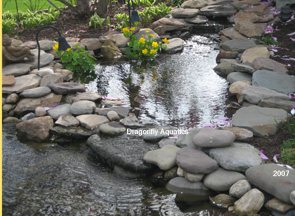 We have been waiting all winter for spring to arrive and can hardly wait to spend time enjoying our water gardens again. The transition from winter to spring can bring new challenges in the water garden. However, with a little work and a lot of patience, your pond will again return to its sparkling, clear magical state.
We have been waiting all winter for spring to arrive and can hardly wait to spend time enjoying our water gardens again. The transition from winter to spring can bring new challenges in the water garden. However, with a little work and a lot of patience, your pond will again return to its sparkling, clear magical state.
In the winter, your pond and its inhabitants sleep. With the onset of spring, fish wake up, begin searching for food and the dreaded algae re-appears with a vengeance. The water we had sparkling clear in the fall, soon turns murky green.
If you were diligent in the fall, by keeping most of the leaves and twigs out of your pond, your task this spring will be much simpler. (unfortunately for me, I was not diligent enough!) If not, the first thing you will want to do is net out as many leaves and debris as possible with a net. Re-start your pumps and filter systems. If you have a skimmer and a puri-falls, now is a perfect time to clean them out thoroughly. Either clean your filter media or replace with new. If you clean your filter media, it is always best to rinse it in pond water, so as not to kill the "sleeping bacteria" from last year. After you have removed as much debris as possible, you can vacuum the rest with a Muck Vac or where vacuuming is impractical, such as in ponds with rock or gravel bottoms, adding Microbe-Lift SA will help speed up the biological removal of slow to degrade organic waste matter from aquatic pond bottoms, that may become toxic to fish and plant life. Microbe-Lift SA removes bottom organic sludge and helps clarify your pond water at the same time. Another option at this time would be to add Microbe-Lift Spring Summer Cleaner, it helps jump start your pond to a healthier environment in the spring, by reducing buildup of dead leaves and organic sediment. Microbe-Lift Spring Summer Cleaner is a seasonal approach to the proper organic balance in ponds. The main thing you want to achieve is to get the bacteria started and growing again in your pond. As the water warms, the species of bacteria that convert ammonia to nitrite slowly awaken as water temperatures rise above 55 degrees. The species of bacteria that convert deadly nitrites to harmless nitrate are slower to start in the spring, usually 2 to 3 weeks behind, depending on water temperatures. As your fish awaken from the winter, begging for food, it is best to refrain from feeding them at this time. Food eaten at this time will become toxic by products until the bacteria can catch up. The higher the protein in the fish food, the more ammonia will be produced. If you feel you must feed your fish, it's best to feed Microbe-Lift Spring/Fall formula fish food, or Tetra Spring Diet, which consists mostly of wheat germ, and do so sparingly.
Many people, when their ponds are full of sludge, leaves and algae, are tempted to drain the pond and start over. Try to avoid this method, if at all possible, especially if you have a large pond. When you completly drain a pond and start over, you destroy all of the good bacteria you have been growing and stress your aquatic life. It is always preferable to work with "aged water". Although at times, a partial water change can be beneficial. I would change no more than 10% to 30% of the pond though.
In Ohio, we are still experiencing some unusually cold days, the greenhouses are warm though, plants are growing and blooming and I'm sure within the next two weeks, I will be out tackling the leaves and muck in my pond. Hopefully I will learn my lesson, and next fall, leave the pond netting on all winter! Hang in there everyone, Spring is just around the corner!